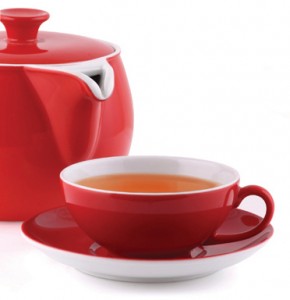Tea Time
By Mary Beth Schwartz
 A Cup A Day Keeps The Doctor Away
A Cup A Day Keeps The Doctor Away
More tea is drunk around the world than any other beverage. In fact, in China, tea is a core component of both casual and formal occasions. The art of drinking and serving tea is a time to relax and enjoy its taste and smell. In Japan, tea practitioners study for years to be able to perform the art of the tea ceremony that was started in the late 12th century and influenced by Zen Buddhism. The British have been serving tea for hundreds of years in royal silver, bone china, and the classic red clay Brown Betty. They drink approximately 3.32 cups of it a day with milk and/or sugar.
When most think of tea, they envision the commonplace Salada or Lipton tea bag. Loose leaf tea is broken down into four groups—white tea, green tea, oolong tea, and black tea. White tea is obtained from the first silver-haired buds of the Camellia sinensis plant. This mild tea is the least processed. Green tea is a bit stronger than white and resembles the green tea leaf. Oolong tea is partially fermented tea—it is withered, then partially oxidized and dried. Black tea, the most popular among tea drinkers, is the most processed—it is both fermented and oxidized.
Tea starts with the thought process of relaxation and calming down for a period, and ends with health benefits. According to the Tea Association of the United States of America, the naturally occurring flavonoids in tea are thought to have antioxidant properties. Antioxidants work to neutralize free radicals, which over time, damage body elements and lead to chronic diseases. Studies show tea’s role in the reduction of cancer risk, including digestive cancers, skin cancer, oral cancer, lung cancer, and ovarian cancer.
Recent findings of studies presented in a report by the Tea Association of the United States of America reveal tea’s influence in cardiovascular health. Human population studies have found that people who regularly consume three or more cups of black tea per day have a reduced risk of heart disease and stroke. Researchers from the United States Department of Agriculture (USDA) studied the effect of tea on 15 mildly hypercholesterolemic adult participants following a “Step I” type diet moderately low in fat and cholesterol. After three weeks, researchers found that five servings of black tea per day reduced LDL (bad) cholesterol by 11.1 percent and total cholesterol (TC) by 6.5 percent.
Further research of tea consumption has shown additional findings collected by the Tea Association of the United States of America. One, tea may contribute to oral health. The flavonoids in tea may inhibit the plaque-forming ability of oral bacteria and the fluoride in tea may support healthy tooth enamel. Two, researchers from Brigham and Women’s Hospital and Harvard University recently published data indicating that tea contains a component that can help the body ward off infection and disease and that drinking tea may strengthen the immune system. Three, preliminary research suggests that drinking tea may have effects on body weight, fat accumulation, and insulin activity. Four, tea consumption has reduced the likelihood of recurring kidney stones. Finally, studies are underway on the effects of tea in reducing the risk of osteoporosis.
Tea starts with the thought process of relaxation and calming down for a period, and ends with health benefits
In order to obtain the health benefits of tea, it is best to consume freshly brewed loose leaf tea. Use newly drawn cold water or bottled spring water in a tea kettle. Green and white teas should be boiled 160 to 180 degrees, oolong tea 180 to 190 degrees, and black tea 200 to 210 degrees. Black and oolong teas should be brewed for five minutes, while green and white teas brew for one to two minutes. Do not overload tea with lots of milk, sugar, or artificial sweeteners. A touch of locally grown honey can add natural sweetness.
If you wish to enjoy tea out in the Lehigh Valley, there are a variety of tearooms to visit. Sweet Memories in Emmaus offers up to 30 varieties of tea along with their lunch, brunch, and dinner menus. The tearoom and country store is known for their scrumptious homemade desserts. Reservations are recommended, and are required for Sunday suppers. The Lavender and Lace Tea Rooms at the Blue Butterfly Gift Shop, also in Emmaus, offer luncheon tea, afternoon tea, and tea parties for children. Reservations are recommended to enjoy their 15 varieties of tea, along with tea sandwiches, scones, and petit fours. McCarthy’s Tearoom and Restaurant at Bethlehem’s Donegal Square offers native dishes from Northern Ireland—many of which are family recipes. Friday night’s special is their signature fish and chips—reservations are recommended. Guests can book a special tea party at McCarthy’s complete with savories, fresh scones, and a choice of 60 varieties of tea. Jessica’s Tea Room at the Weaversville Inn, located in Northampton, is open for tea, lunch, dinner, and private birthday tea parties for children. Jessica’s tea menu features scones with Devonshire cream, lemon curd, and jam; finger sandwiches with edible flowers; an array of pastries; and a selection of 50 different teas. For those of you who are true tea enthusiasts, traveling around the country to visit tearooms is a part of the tea experience. Two websites, teamap.com and teaguide.net, are good resources to consult.
Whether drinking for fun, or to take advantage of its health benefits—hopefully both—tea is a popular choice among Lehigh Valley residents.
Mary Beth Schwartz is a home and garden editor and tea enthusiast. She has visited tearooms along the East Coast and in Europe.




